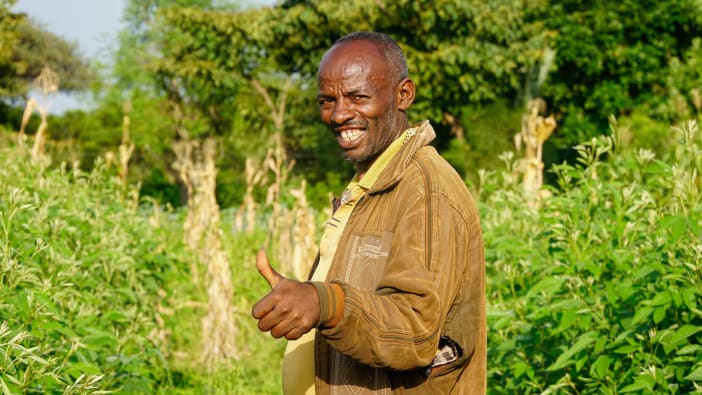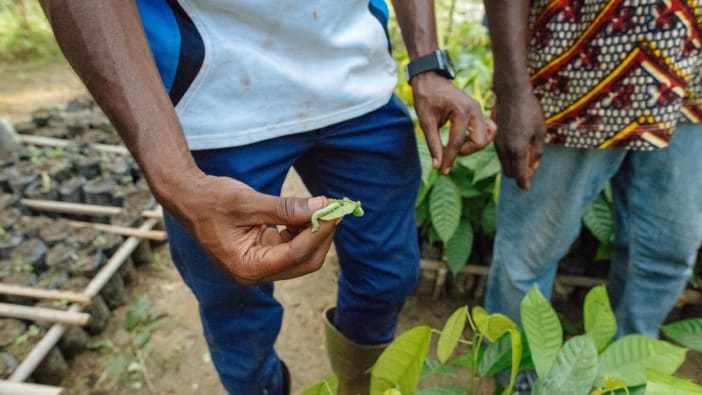Burkina Faso is an inland country in West Africa. The north of the country experiences a hot dry climate while the south receives more rain. Rainfall is irregular and for 30 years Burkina Faso has had very poor rains with three particularly severe droughts (1973–1974, 1983–1984 and 2000–2001).
The soils are generally of poor quality, partly due to erosion. Yields are low and have resulted in a shortage of grain with famine in areas of the north and central plains.
Increasing population growth puts more pressure on farming and the environment. In addition, for 20 years there have been high levels of internal migration. Many farmers from the north and central plains move to the lowlands in search of land to rent. Usually one member of the family goes first and then calls others to follow. In some areas there are now as many migrants as indigenous people. This is threatening the local customs and language. Sometimes migrants use dry riverbeds to plant crops. If rain does fall, these crops are often ruined because the riverbeds fill with water. CREDO, a Tearfund partner, is working to mobilise grass-roots agricultural projects with very positive results.
Farmers in Burkina Faso have suffered from the impact of the changing climate for many years. Over time they have been adapting their farming practices to protect themselves from the endless cycles of drought and poor rainfall.
Following are some of the most well used techniques and ideas.
Sowing in dry ground
In order to avoid wasting a single drop of the very first rains, seeds are sown in dry ground just before the rains begin. This means that even the lightest rainfall is used for crops to begin growing.
Fast-growing varieties
Many farmers in the south of the country have begun using fast-growing varieties of millet, maize, sorghum and rice (normally only used in the dry north), even though they know these give lower yields.
Improved seed
Government research centres have produced improved seed varieties that have become popular with NGOs and farmers. These seeds are now widely accepted and appreciated by farmers.
Animal traction
Farmers are very aware of the benefits of using animal power in farming to make sure land is ploughed and seeds sown as soon as the rains begin. The only problem is access to the animals and ploughs, which is beyond the reach of many farmers. CREDO helps by distributing ploughs.
Land-clearing
In order to be certain of harvesting something each season, farmers in wooded areas do not hesitate to chop down a little of the remaining forest every year in order to use the most fertile ground possible. People cut wood and sell it in the city. Farmers don’t always realise the importance of trees. CREDO encourages communities to have forest management committees, recognised by the government, to train people to manage the forest so that there is a balance between cutting and planting.
Radio programmes are broadcast in local languages on the importance of tree planting and school pupils are encouraged to plant and care for 200 trees in each school.
Training in sustainable agriculture
Long-term training (for eight months) is given to young farmers on animal traction, breeding and farm management. They are taught about sustainable agriculture, agroforestry, tree nurseries and market gardening. Following training, these farmers can have a big impact in their villages. Their crop yields often double, some have even tripled their yields. This helps other farmers in the villages to be more willing to learn from the knowledge these trained farmers can share.
Yanogo André is the development programme co-ordinator for CREDO. CREDO, 01 BP 3801, Ouagadougou 01, Burkina Faso. Email: [email protected]
Zai technique
This is a traditional agricultural practice that is particularly useful in poor infertile soils. Small pits measuring 20–30cm across and 10–20cm deep are dug. Two handfuls of crop waste or animal manure are placed in the pit and covered with a little soil. When the rains begin sorghum or millet seeds are sown in the pits. These pits are useful because precious rainwater collects in them and they make the most effective use of small quantities of organic waste and manure.
Animal manure gives better results than crop wastes as it is a more concentrated fertiliser. Composting crop wastes before use improves fertility, but takes more time. It can be hard work to dig the zai pits but it can be done during the dry season when there is less other work. This simple technique is providing farmers with increased crop yields in Burkina Faso.








